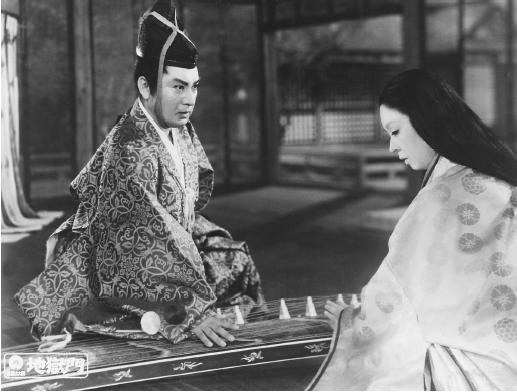JIGOKUMON - Film (Movie) Plot and Review
(Gate of Hell)
Japan, 1953
Director: Teinosuke Kinugasa
Production: Daiei (Tokyo); Eastmancolor, 35mm; running time: 89 minutes. Released 1953, Japan. Filmed in Japan.

Producer: Masaichi Nagata; screenplay: Teinosuke Kinugasa, from a 20th century play by Kan Kikuchi; photography: Kohei Sugiyama; art director: Kisaku Itoh; music director: Yasuchi Akutagawa; costume designer: Sanzo Wada; color consultant: Sanzo Wada.
Cast: Machiko Kyo ( Wife ); Kazuo Hasegawa ( Husband ); Koreya Senda; Isao Yamagata; Yataro Kurokawa; Kataro Bando.
Awards: Oscar for Best Costume Design-Color and Special Oscar for Best Foreign Film, 1954; New York Film Critics' Award, Best Foreign Film, 1954; Cannes Film Festival, Best Film, 1954.
Publications
Books:
Shinobu Giuglaris, Marcel de, Le Cinéma Japonais , Paris, 1956.
Anderson, Joseph, and Donald Richie, The Japanese Film: Art and Industry , New York, 1960; revised edition, New Jersey, 1982.
Articles:
Life (New York), 15 November 1954.
Knight, Arthur, "Japan's Film Revolution," in Saturday Review (New York), 11 December 1954.
Ozaki, Koji, in Atlantic (Boston), January 1955.
Iwabutchi, Masayoshi, "1954 in Japan," in Sight and Sound (London), Spring 1955.
Young, Vernon, "Reflections on Japanese Film," in Art Digest (New York), August 1955.
Anderson, Joseph, "Seven from the Past," in Sight and Sound (London), Autumn 1957.
Cohen, R., "A Japanese Romantic: Teinosuke Kinugasa," in Sight & Sound (London), vol. 45, no. 3, Summer 1976.
Checklist and critical notes on Teinosuke Kinugasa, in Film Dope (Nottingham), no. 31, January 1985.
* * *
Although today Teinosuke Kinugasa's Jigokumon is seldom treated as an important film, its historical position is secure. It was one of the first post-World War II Japanese films to be accepted and honored by the international film community. Not only did it win the Grand Prize at the 1954 Cannes International Film Festival but also it received two Academy Awards in the United States.
The great commercial and critical success of Akira Kurosawa's Rashomon (1950), Kenji Mizoguchi's Ugetsu (1953), and Jigokumon made the Western world begin to take notice of Japanese films.
Jigokumon was especially noteworthy to Western audiences because it was the first Japanese color film released in the West. Although the Eastmancolor film stock came from the United States, Kinugasa and his cinematographer, art director, and color consultant used it with an artistry and subtlety that was seldom seen in the American films of that time. Many critics praised the filmmakers for giving the color a distinctly Japanese look that was a welcome contrast to the flamboyance of Hollywood.
Although Jigokumon is set in the 12th century, it is based on the 20th-century Japanese play by Kan Kikuchi. The film begins with a war between rival clans, and then, when the war is over, concentrates on only three characters in a story of love, sacrifice, and grief.
The direction of Kinugasa gives intimacy to both parts of the film, even the battle scenes. Kinugasa often highlights the large-scale sequences with small details in the foreground or at the end of a scene. In one scene, for example, the march of warriors in the background is accentuated by a number of chickens fighting in the foreground, and many scenes that involve large numbers of fighting men end with a quiet close-up of an inanimate object.
The second part of the film contrasts the emotion and brutality of the warrior Moritah with the restraint of a man and his wife who value self-sacrifice above violence and revenge. When Moritah tries to take the wife away from her husband, she sacrifices her life rather than accept the warrior; after her death, the husband refuses to take vengeance. The warrior finally realizes that he must atone for his sin by continuing to live with the knowledge of what he has done. This is not a familiar theme for Western audiences, but under Kinugasa's direction the performers who play the couple convey the depth of their feeling without much overt show of emotion. (The wife, incidentally, is played by Machiko Kyo, who also was featured in Rashomon .)
Jigokumon is only one of the many fine films directed by Teinosuke Kinugasa in a career that spanned five decades, but to Western audiences it was a revelation in the artistry of its color and the strength of its story. The audiences that had appreciated the black-and-white masterpieces of Kurosawa and Mizoguchi were astonished by Kinugasa's use of color film. The American Motion Picture Academy gave Sanzo Wada its award for costume design, and because at that time the Academy had no foreign film category, it gave Jigokumon a special award as Best Foreign Film.
—Timothy Johnson
Comment about this article, ask questions, or add new information about this topic: